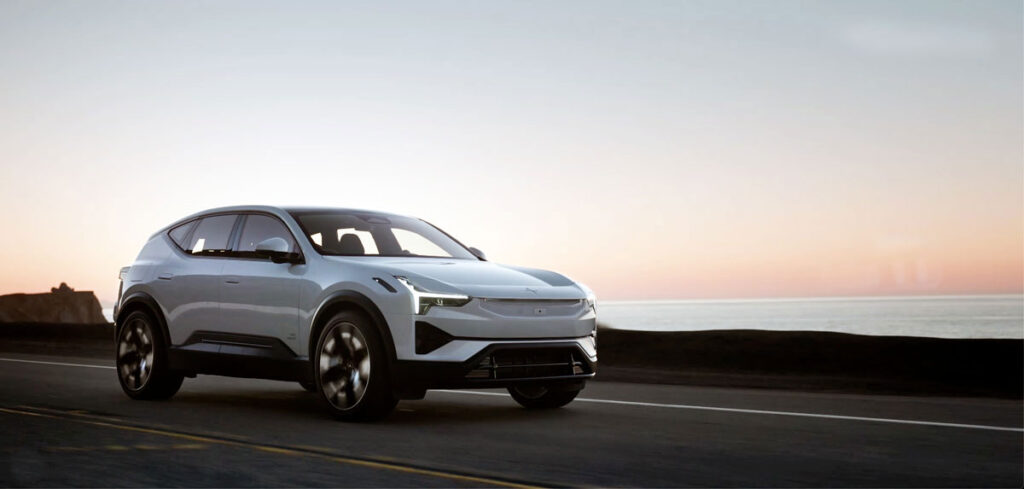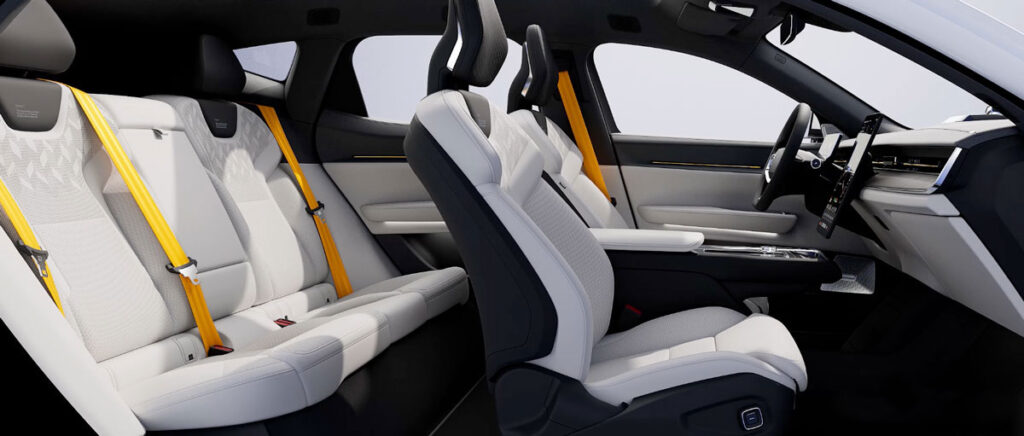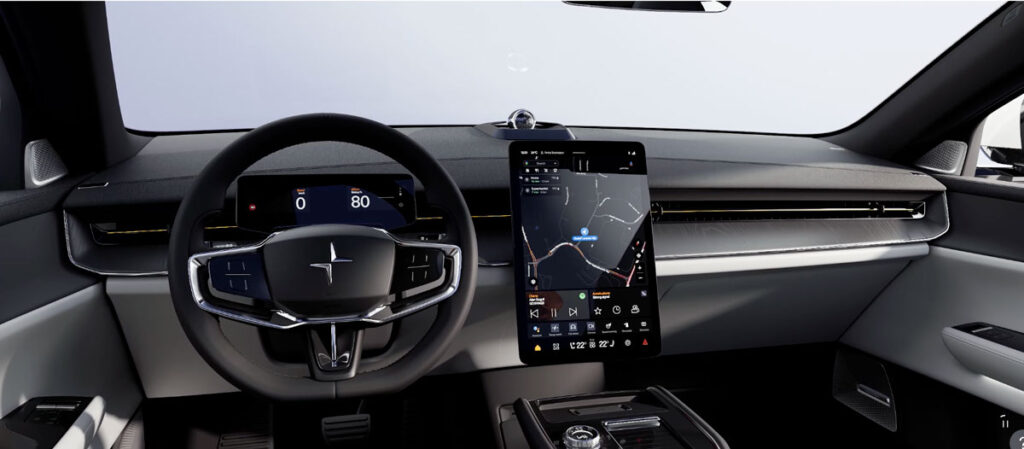The Polestar 3 is a great choice for you in the premium SUV sector, with a luxurious interior and robust equipment. The new Polestar 3 has a dramatic design and comes with a leading range of 350 miles.
| Vehicle | Polestar 3 Long Range Dual Motor Performance Pack |
| Price: | £81,500 |
| Top speed | 130mph |
| Range | 349 miles |
| Battery size | 111kWh/107kWh (total/usable) |
| Drive battery: | Lithium ion, NMC |
| Energy efficiency | 3.7mpkW |
| Max. charge rate | 250kW |
| Kerb weight (DIN) | 2584-2670kg |
| Power | 483bhp (510bhp with Performance Pack) |
| Torque | 620lb ft (671lb ft with Performance Pack) |
| 0-62mph | 5.0sec (4.7sec with Performance Pack) |
| Electric motor/s: | Two permanent magnet synchronous motors |
| Driveline layout: | Dual motors, 4WD, with rear torque-vectoring device |
| official website | https://www.polestar.com/global/polestar-3/ |
The Polestar 3 will be the largest vehicle in the Swedish company’s range, measuring 4.9 meters in length, 1,614mm in height, and 2,120mm wide (including mirrors). Its wheelbase is almost identical to the iX at 2,985mm long.

The Polestar 3’s dual-motor powertrain is powered by a 107kWh battery, housed within the new SPA2 architecture that will also form the basis of the new Volvo EX90. The two motors together produce a total of 483bhp and 840Nm of torque in the regular Launch Edition, while with the Performance Pack it produces 510bhp and 910Nm of torque.
There’s only one powertrain available on the Polestar 3, a dual-motor set-up powered by a larger 107kWh battery. The standard car has 483bhp of power and 840Nm of torque, allowing it to do 0-62mph in just five seconds. The Performance Pack increases this power to 510bhp and torque to 910Nm, reducing the 0-62mph time to 4.7 seconds. Both versions have a top speed of 130mph.
Polestar 3: Price, specifications and rivals
Polestar was well known in motorsport circles as a racing team but in 2017 it became an independent brand looking very much in the direction of electric vehicles. First came the Polestar 1, then the Polestar 2 in 2020, and now the Polestar 3 will launch in 2024 – with the Polestar 4 coming soon. Polestar has an alphanumeric naming system so there will never be another Polestar 3.
As a fully electric large SUV, the Polestar 3 will compete with vehicles like the BMW iX, Audi Q8 e-tron, Mercedes EQE SUV and even the Volvo EX90. The ‘Launch Edition’ will be offered for around £75,000 and there will be the option of a ‘Performance Pack’ which adds more power and some exterior changes. The Polestar 3 will only be offered with a dual-motor at launch although Polestar has confirmed a single-motor ‘Long Range’ will arrive in 2025 which will likely reduce the price of the Launch Edition.
The Polestar 3’s design is influenced by aerodynamics. Like the 2020 Polestar Precept concept, its rounded front end comes with a low nose with channels in the body that send air over the bonnet and rear spoiler. Polestar considered adding digital wing mirrors to reduce aerodynamic drag by 0.29CD, but did not include it. However, the technology can be added in the future as per demand. Polestar claims that four over-the-air updates will be made every year, which will include improvements to the powertrain’s efficiency.
Polestar claims that its SUV will return an efficiency rate of 2.9 miles per kWh, which is not great, especially compared to the Mercedes EQE SUV’s 3.3 miles per kWh. The Long Range Dual-Motor Launch Edition has an electric range of 390 miles, while the Performance Pack reduces it to 349 miles. The Polestar 3 has a virtual torque vectoring system with dual-clutch for the rear motor, allowing the rear motor to be disengaged to increase efficiency. During our drive we saw a figure of 2.4 miles per kWh, which would have given a range of 256 miles based on the usable battery capacity.
| Model | Battery size | Range |
| Polestar 3 Long Range Dual-motor | 107kWh | 390 miles |
| Polestar 3 Long Range Dual-motor Performance Pack | 107kWh | 349 miles |
The Polestar 3’s SPA2 platform uses a 400V architecture rather than the 800V architecture used in electric cars such as the Porsche Taycan. It has a larger 107kWh battery, but can handle DC charging at up to 250kW, taking 30 minutes to charge from 10-80 per cent. Fully charging at home using a typical 7kW wallbox charger can take up to 17 hours.
Engine, performance and Drive
The Polestar 3 is based on the same SPA2 architecture as the new Volvo EX90 – the XC90’s all-electric replacement. During our Polestar 3 experience, Polestar reiterated its intention to create a dynamic, driver-centric experience – unlike the Volvo.
This is a hefty electric SUV weighing 2,670kg, but the Polestar 3’s centre of gravity is similar to the smooth Polestar 1 coupe. It has 483bhp and 840Nm of torque, while the Performance Pack version we drove has 510bhp and 910Nm of torque.
| Model | Power | 0-62mph | Top speed |
| Polestar 3 Long Range Dual-motor | 483bhp | 5.0 secs | 130mph |
| Polestar 3 Long Range Dual-motor Performance Pack | 510bhp | 4.7 secs | 130mph |
Boot space, comfort & practicality
| Length | 4,900mm |
| Width | 2,120mm |
| Height | 1,614mm |
| Number of seats | Five |
| Boot space | 484 litres |

Polestar 3 Interior, Design, and Technology
The Polestar 3 is a technologically advanced vehicle and features a high-quality interior design. Its design is heavily influenced by the 2020 Precept concept and it stands out with its uniqueness in the luxury SUV segment. Polestar proudly states that “aerodynamic elements have been incorporated into the exterior design, working together to enhance handling and efficiency”. Most significant are the front and rear aero wings that direct airflow around the car. Flush side windows and flush-fitting door handles also help with aerodynamics.
A few exterior labels have been added on the Polestar 3, which reflect the car’s technology. There is a ‘SmartZone’ badge at the front, located next to the eight-megapixel camera. The Performance Pack also has a small badge, although in both cases, the badging can be removed at no extra cost. There are also side labels indicating the car’s battery capacity, which also appears on the Polestar 2.
Colour options include six, including a couple of greys, a white, a black, and a dark blue. However, the most striking colour option for us was the golden ‘Jupiter’ metallic.
Inside the Polestar 3, you’ll find the overall minimalist layout reminiscent of the Polestar 2, but it feels more spacious and premium. It doesn’t have the bright dazzle of the BMW iX’s interior, nor the huge screens of the Mercedes EQE SUV, but the Polestar is well-constructed throughout the interior.

Almost every surface feels high quality. Compared to the Polestar 2, the headlining is softer, the faux leather feels more cushioned, and the centre console and doors feel sturdier. Polestar has also offered the option of a Nappa leather interior in collaboration with Bridge of Weir. This option includes ventilated front seats, powered side support, and massage function. There’s also the option of a black ash dash. Our Performance Pack trim included a few extra details like ‘Swedish gold’ seatbelts.
Also Read… Tata Altroz Racer
Polestar 3 Review
The Polestar 3 offers a mature but largely forgettable driving experience. Driving around in the Polestar 3 makes you feel like you’re in a big vehicle. At slow speeds, road bumps and potholes are smoothed out by the standard-fit, self-levelling dual-chamber air suspension and adaptive dampers. The standard set-up feels too soft and floaty, which makes the Polestar 3 feel heavy in the city. The quick and light steering can lead to some pitch and tilt. It’s not bad in densely populated areas, though.
The ridges on the outer edges of the bonnet make it easy to spot on the road and forward visibility is excellent, though the rear-view mirrors give you a clear sense of the distance to the rear window. The 11.8-metre turning circle isn’t bad, especially considering there’s no rear-wheel steer technology.
Damping is good when picking up speed on the motorway, and even on the 22-inch wheels and Pirelli P Zero tyres, the ride is comfortable. Not just road imperfections but there is very little road noise entering the cabin and even wind noise stays at bay despite those wide Pirelli tyres.
The dampers can be set in three modes – ‘Standard’, ‘Nimble’ and ‘Firm’. There wasn’t much difference between Nimble and Firm but we definitely felt the Polestar 3 was more stable with these modes and required less steering input while cruising.
The steering also has three modes: ‘Standard’, ‘Firm’ and ‘Light’. The steering feels more supportive in the firm mode so if you’re driving fast it might be better to keep it in the light mode so you can make the most of a comfortable driving experience. There’s not much communication from the steering in turns which is a little disappointing as the front end responds quickly and the overall balance of the Polestar 3 is spot on but it’s difficult to turn it around in turns.
There’s an option to change the traction control to ‘Sport’ mode which allows the rear to slip a little when you give it throttle. This is good for driving as more slip than this can make it difficult to maintain the steering. The Polestar 3 offers good grip, and as long as you’re precise with your inputs you can go pretty fast.
It’s worth noting that while the Polestar 3’s driving position is excellent for a sporty SUV we did touch the central touchscreen five times to change the steering wheel position which is a lot. During our drive we noticed that the rear motor disengaged, making the car front-drive only. We were told that the UK launch cars would not have this problem.
There isn’t much adjustability in the brakes. There’s a one-pedal mode called ‘High’. There’s a less aggressive brake regeneration mode called ‘Low’, or you can coast by turning off brake regeneration in ‘Off’ mode. The pedal feel is better when the brakes are in Off mode but the transition between lifting off the accelerator and regeneration being activated feels quite smooth. The stopping power available is quite impressive with Brembo four-piston calipers and 400mm drilled and ventilated discs at the front and 390mm discs at the rear.
Warranty and Servicing
The Polestar 3 is guaranteed for three years or 60,000 miles. The battery is separately guaranteed for eight years or 100,000 miles, whichever comes first. If the battery health drops below 70 percent in the first eight years, the battery will be replaced at no cost during the warranty period.
The Polestar 3 is serviced free for the first three years or 31,250 miles, including scheduled maintenance. There are 93 Polestar service points in the UK.
- Carsales.com.au Review: Revolutionizing the online automotive marketplace tailored to people’s needs in 2024
- XVideos : A Comprehensive Guide to the Popular Adult Website 2024
What is the Polestar 3?
The Polestar 3 is a premium electric SUV from the Swedish company Polestar, known for its luxurious interior, robust equipment, and impressive range.
When will the Polestar 3 be launched?
The Polestar 3 is set to launch in 2024.
How does the Polestar 3 compare to other vehicles?
The Polestar 3 competes with the BMW iX, Audi Q8 e-tron, Mercedes EQE SUV, and Volvo EX90 in the premium electric SUV segment.
What is the range of the Polestar 3?
The Polestar 3 has a leading range of up to 350 miles.
What is the top speed of the Polestar 3?
The top speed of the Polestar 3 is 130mph.
What is the price of the Polestar 3?
The ‘Launch Edition’ of the Polestar 3 is priced around £75,000.




